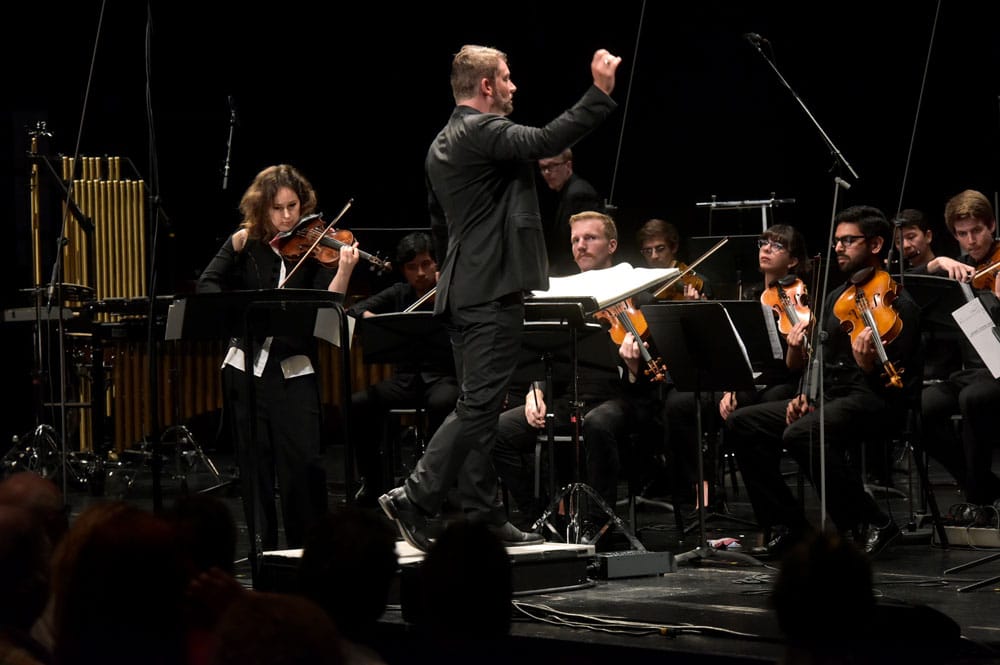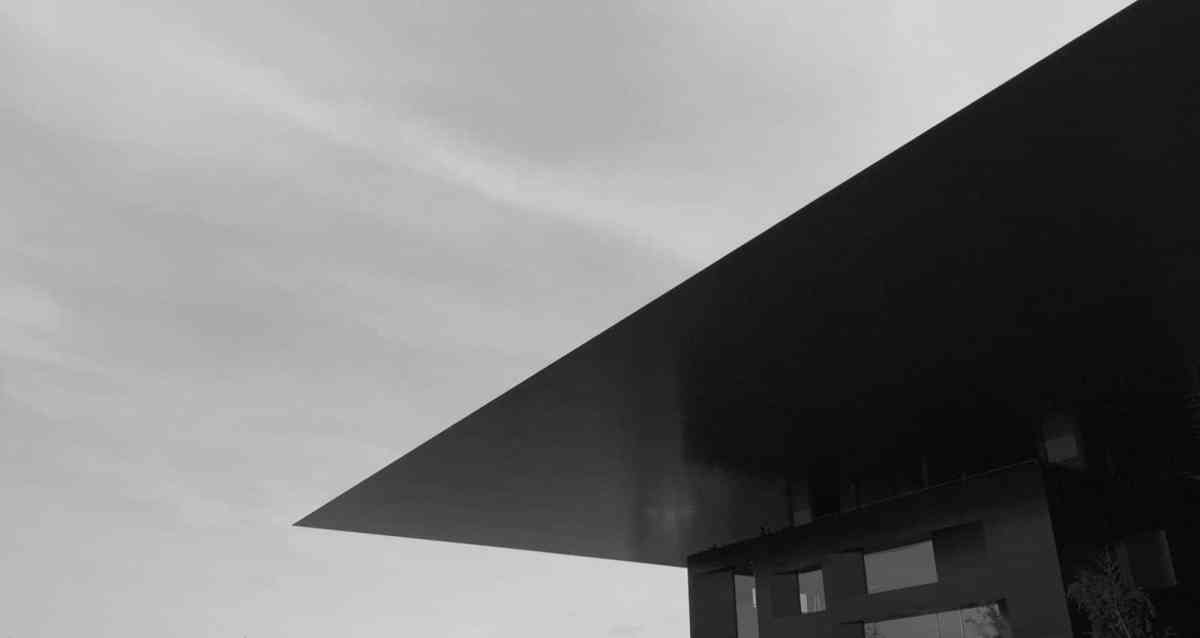Heinz Holliger sits on the edge of his seat, moving his hands knowingly to the atonal wanderings of Frédérique Cambreling’s harp. His face cycles between anticipation, excitement, and a little thrilled relief. Holliger is watching the world premiere of the full version of his Partita No. 2 for Harp, which is stretching both the limits of the instrument’s potential, and the span of Cambreling’s hands. Between movements, he leans forward and whispers excitedly to friends in the next row, and gathers glances of support from others in the room. The audience and music are squared by the bright, art-clad walls of the art museum in the Kultur- und Kongresszentrum Luzern—a building as much a symbol of spatial experimentation as it is a container for musical rule-breaking. The piece is challenging for the audience too, and departs dramatically from built expectation as moments of solace in repetition are dashed by slaps and discordant interruption. There is a certain violence to it, though Holliger might not agree; when the piece stops, he jumps to his feet and is the first to clap with a smile nothing in the moment can shake. The performance is clearly a success.

I ask myself how many moments like this will punctuate the month-long summer festival at Lucerne—moments which mark the realization of work long in the making. The festival’s invitation to attend, (and, full disclosure, to pay for my travel and hotel), gave me the opportunity to experience a couple of such realizations. The night before, composer-in-residence Michel van der Aa sat in the center of the KKL’s Luzerner Saal, sheet music spread out in front of him, and followed intently as Matthias Pintscher led the Lucerne Festival Academy Orchestra through the Swiss premier of his “Hysterisis.” It’s a piece comprised of ghost echoes and shadows, as the lead clarinet is chased by the ensemble; an electronic reverb component, in turn, generates an extended resonant trail. These acoustic trails sometimes work with the ensemble’s progression through the piece, and sometimes against it. A kind of friction is exponentially built toward a critical mass, at which point the piece undergoes a total rhythmic and tonal collapse, leaving in its wake a zero-level void that waits to be filled. The piece is paired with two of György Ligeti’s Concertos—for violin and piano, respectively—a programming move that enthusiastically takes up the “identity” theme. The genealogy of “Hysteresis” passes through the two works from Ligeti, and both composers continually pull the rug from under our feet. As well as consulting its predecessors, van der Aa’s Concerto confronts its own immediate resonant past and builds further upon it in a kind of real-time inherited development. For Ligeti, this involves folk invocations, African polyrhythms, and musical signifying and juxtaposition on compositional practices that span hundreds of years. The festival’s “artiste étoile,” Patricia Kopatchinskaja, performed his Violin Concerto as a radical juggling-act of these wildly disparate elements, picking up and emphasizing the piece’s humor and juxtaposition. Small swells of laughter throughout the audience in the final movement illustrate a shared kind of disbelief that she manages to keep everything in the air.
“Identity” is a theme that inherently fits to any music and its historical influence and development. There’s no such thing as music without it. While at first this might seem like a fairly straightforward theme for the festival, it enables an interesting mode of programming. Its main aim, however, according to the festival itself, is to engage in the wider sociopolitical discourses of the present moment: the refugee crisis, emergent far-right sentiment, questions of nationality, and border politics. “Identity is affected by our living conditions and preferences—and to be sure, by both how we want to see ourselves and how we would like to be seen by others,” according to the festival organizers. It’s the kind of statement that makes me ask how exactly the Lucerne Festival itself wants to be recognized. Certainly, in Lucerne, the preoccupation with how one is seen dominates the environment. Supercars tear down the busy street, flanked by banks and designer jewelry stores. Haut-high-heel-couture taps out its pedestrian rhythm on the pavement as concertgoers make their way over the Seebrücke to the Bahnhofquai and on to the KKL, and by night Chanel bags caddy concert tickets into the slick foyer. Although this might not be the spirit of identity the festival theme is going for, it comes with the territory—although free concerts held on the square outside attract herds of sun-hatted tourists with ice-creams in hand, ticket prices for performances within the hall that run into the hundreds render a clinging sense of elitism unshakable. While sitting outside in the sun I’m asked—in French—by a young couple if I have some change for food, and it hits me that what would be an everyday occurrence in London or Berlin seems drastically out of place here. I look around at the money on display and question what the hopeful exploration of “identity” through the festival’s performances means in anything other than aesthetic terms. Are they preaching to the choir here—albeit a fairly affluent one—through their concern with the current political moment? I get the impression that this is something of which the Lucerne Festival are acutely aware, and have made efforts to reflect in their programming—perhaps because diversifying the clientele is partially out of their control when the financial demands of the world’s leading orchestras come into play.

A staging of Mozart’s “Idomeneo” at the festival is an attempt to reach a diverse audience. Cheaper tickets—though unlike some of the more prestigious concerts, not sold out—means greater accessibility, and the opera’s mission to engage with the political situation of Europe could perhaps find no better place to be performed than in a country so central to the continent. “Idomeneo” is a story of displacement, war, refuge, and Mediterranean passage that reflects the refugee crises of today so closely as to be a little unnerving. This performance, comprised of the Stuttgart Philharmonic Choir, the Zuflucht refugee choir, and the BandArt Orchestra, transposes the opera’s original plot onto the conflicts of today. Performing around a slanted platform reminiscent of the crowded, sinking boats that have become ubiquitous with our media-informed image of the crisis, members of Zuflucht (literally, “refuge”) tell their own stories of fleeing violence, bringing on stage the items they carried to Europe—glasses, a jacket, even a scarf that made the flight from Palestine to Syria with a man during a past conflict, only to be brought from there to Germany by his niece years later. Cohesion is somewhat lacking in places—a sex-scene almost as difficult to watch as it looks awkward to perform involves the removal of a number of separate hooded sweatshirts, which throughout the rest of the action are zipped and unzipped compulsively to no apparent end, producing within me that uncomfortable feeling which occurs when somebody continues wearing a coat indoors. Some lackluster video elements, and somewhat confusing and mildly tasteless gunshots dilute some of the production’s potential. Much of this, however, is pulled back into place by the orchestra, whose conductorless lead holds the more disparate parts of the performance together. Samir Mansour’s integration of the Oud with the orchestra, and a short but powerful trail of Arabian improvisation in one cello part brings Mozart’s otherwise distant score into a closer relief with the issues explored through the direction—although moments like this also serve to remind those of us sitting in the KKL just how far we really are from the actual human conflicts of which the production aims to make us conscious. For the most part, the production is a powerful and refreshing provocation of an audience whose lives are wildly distant from those depicted. It’s possible that the disparate and less slick parts work to resist the usual pomp and exclusivity of staging operatic performances, which would otherwise look ridiculous against the political backdrop the production brings to the fore.
Young players from China and Europe with sticker-bombed cello cases in tow spend their off-time traversing the river Reuss before it breaks out into the crystalline Lake Lucerne. The KKL’s canopy cuts a sharp silhouette against the sky that reflects in abstract ways the water below. Inside, the well-oiled Erlebnistag continues. Folk roots and slave routes are interrogated through its programming: in the opening concert, Jordi Savall wants to make clear that the atrocities of the past are fundamental to the economic primacy of Europe and the U.S. today. But again, with Nestlé and Roche—multinationals that have seen their fair share of controversy—it’s easy to question the symbolic validity such explorations have on anything greater than a personal level. Visitors from Europe, China, and the Middle East saunter past, many here only to visit the city itself, unaware that their presence reinforces the Lucerne Festival’s endeavors to stage itself as a globally-implicated cultural event. Nestled within the Alps, we’re a long way from the implications of world-political turmoil. Lucerne has always enjoyed a position of neutrality and safety, which simultaneously renders it somewhat disconnected from, but also enabled to objectively consider, the wider situation of a point in time. (The festival’s fledgling years coincided with the onset of World War II.) Yes, it has a responsibility to check its own exclusivity, but it appears to be making steps in that direction. Certainly, it recognizes its unique position—high up, central, and with a view over the cultural and historical makeup of Europe that is difficult to achieve anywhere else. ¶

